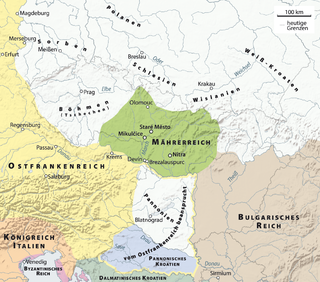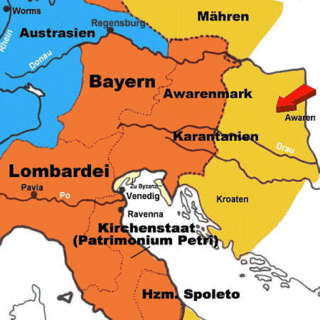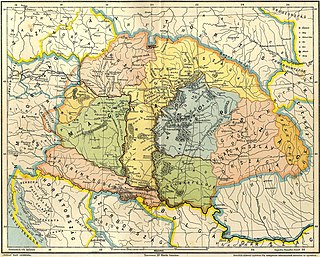
Pannonia was a province of the Roman Empire bounded on the north and east by the Danube, coterminous westward with Noricum and upper Italy, and southward with Dalmatia and upper Moesia. Pannonia was located in the territory of present-day western Hungary, eastern Austria, northern Croatia, north-western Serbia, northern Slovenia and northern Bosnia and Herzegovina.

The Pannonian Avars were an alliance of several groups of Eurasian nomads of unknown origins.

The Principality of Lower Pannonia, also known as the Balaton Principality, was an early medieval Slavic polity, situated in Lower Pannonia, with capital in Blatnograd. The polity was a vassal principality of the Frankish Empire, or according to others, a frontier county of the Eastern Frankish Kingdom. It was initially led by a dux (Pribina) and later by a comes (Kocel, Pribina's son, who was titled as "Count of the Slavs" .. It was one of the early Slavic polities, that emerged during the early medieval period. It was centered in western regions of modern Hungary, but also included some parts of modern Austria, Slovenia, Croatia and Serbia.

Great Moravia, the Great Moravian Empire, or simply Moravia, was probably the first major state that was predominantly West Slavic to emerge in the area of Central Europe, possibly including territories which comprise today the Czech Republic, Slovakia, Poland and Hungary. The only formation preceding it in these territories was Samo's tribal union known from between 631 and 658 AD.
Ban was a noble title used in several states in Central and Southeastern Europe between the 7th century and the 20th century, primarily in the territory of Croatia.

The Pannonian Basin, or Carpathian Basin, is a large basin in Central Europe. The geomorphological term Pannonian Plain is more widely used for roughly the same region though with a somewhat different sense, with only the lowlands, the plain that remained when the Pliocene Epoch Pannonian Sea dried out.

Ljudevit or Liudewit, was the Duke of Pannonian Croatia from 810 to 823. The capital of his realm was in Sisak. As the ruler of the Pannonian Slavs, he led a resistance to Frankish domination. Having lost the war against Franks, he fled to Ljudemisl, Borna's uncle, who treacherously killed him.

Ratimir was a Croatian duke or prince (knez) that ruled the Duchy of Pannonian Croatia between ca. 829 to 838. His name contents the word "rat", meaning "war", and "mir", meaning "peace". It is believed that Ratimir descends from a royal dynasty that provided rulers for Moravia and Croatia.
Braslav was a Slavic prince who ruled the Duchy of Lower Pannonia between 884 and 896 as a vassal of Arnulf of Carinthia. He participated in the Frankish–Moravian War (882–84) and the Frankish invasion of Moravia (891–92). He was last mentioned when he was entrusted Pannonia by Arnulf in order to secure the Frankish frontier against the Hungarians (896), who subsequently overran all of Pannonia and continued into Italy.

Pribina was a Slavic prince whose adventurous career, recorded in the Conversion of the Bavarians and the Carantanians, illustrates the political volatility of the Franco–Slavic frontiers of his time. Pribina was the first ruler of Slavic origin to build a Christian church on Slavic territory in Nitra, and also the first to accept baptism.

Kocelj was a Slavic ruler of Lower Pannonia, a polity known in historiography as the Balaton principality. He was an East Frankish vassal titled comes (count), and is believed to have ruled between 861 or 864 and 876.

The Eastern March or March of Pannonia was a frontier march of the Carolingian Empire, named after the former Roman province of Pannonia. It was erected in the mid-ninth century in the lands of the former Avar Khaganate against the threat of Great Moravia and lasted only as long as the strength of that state. It was referred to in some documents as terminum regni Baioariorum in Oriente or "the end of the kingdom of the Bavarians in the east" and from this is sometimes called the "(Bavarian) eastern march," a term more commonly used to refer to the later Margraviate of Austria, established in 976 as a sort of late successor state. The East Frankish rulers appointed margraves (prefects) to govern the March.

The Margraviate of Austria was a medieval frontier march, centered along the river Danube, between the river Enns and the Vienna Woods, within the territory of modern Austrian provinces of Upper Austria and Lower Austria. It existed from c. 972 to 1156.

The Avar March was a southeastern frontier province of the Frankish Empire, established after successful Frankish campaigns and conquests of Avarian territories along the river Danube, to the east from the river Enns, in what is today Lower Austria and northwestern Hungary. Since the Frankish conquest in the late 8th century, there were several administrative changes in those regions. Territory along the river Danube, from the river Enns to the Vienna Woods, was ruled directly, as a frontier extension (march) of the Frankish Bavaria, while regions further to the east, up to the river Rába, were initially designated to remaining Avarian princes, under the Frankish supreme rule. During the 820s and 830s, additional administrative changes were made in the wider region of Frankish Pannonia, inhabited mainly by Slavs. Territories of the remaining Avarian princes were fully incorporated, and Avars eventually disappeared from the region.
Vojnomir, Voynomir or Vonomir I was a Slavic military commander in Frankish service, the duke of Pannonian Croats, who ruled over Slavonia from c. 790 to c. 800 or from 791 to c. 810.

Posavina is a geographical region that stretches along the Sava river, encompassing only the inner areas of the Sava river basin, that are adjacent or near to the Sava river itself, in Croatia, Bosnia and Herzegovina, and Serbia.
Alternative theories of the location of Great Moravia propose that the core territory of "Great Moravia", a 9th-century Slavic polity, was not located in the region of the northern Morava River. Moravia emerged after the fall of the Avar Khaganate in the early 9th century. It flourished during the reign of Svatopluk I in the second half of the century, but collapsed in the first decade of the 10th century. "Great Moravia" was regarded as an archetype of Czechoslovakia, the common state of the Czechs and Slovaks, in the 20th century, and its legacy is mentioned in the preamble to the Constitution of Slovakia.
Radbod was the East Frankish prefect of the Eastern March, the Bavarian frontier towards the Slavs, appointed in 833. He had been appointed the office after Louis the German's conquest in 828, and subsequent Christianization of the Moravians (828–33). In 833, according to the Conversio Bagoariorum et Carantanorum, a Slavic prince, Pribina, had been "driven across the Danube by Mojmir, duke of the Moravians", and fled to Radbod in East Francia around 833. Radbod introduced him to King Louis the German, who ordered that Pribina should be "instructed in the faith and baptized", and that he serve with his followers in Radbod's army. Before long, however, Radbod and Pribina fell out, and the latter, fearing for his life, fled with his son Koceľ to the First Bulgarian Empire, and then to Lower Pannonia ruled by a Slavic duke, Ratimir. Since Lower Pannonia was part of Radbod's prefecture, Ratimir's harboring of Pribina was tantamount to rebellion, therefore, in 838, Louis the German sent Radbod at the head of a large Bavarian army to crush Ratimir, but Pribina and his followers took refuge with the count of Carniola, Salacho. In short time the latter brokered a reconciliation between Radbod and Pribina, and Louis solved the ongoing instability by appointing Pribina as his faithful dux with lands in around the Zala river. Radbod held contacts with Rastislav, ruler of the Moravians, who had long posed a danger to Bavaria. According to the Annals of St-Bertin, in 853 Charles the Bald, king of West Francia, bribed the Bulgarians to ally with the Slavs and together attack Louis the German's kingdom. In the course of the Bulgarian–Moravian attack, Louis the German deposed Radbod in 854 for infidelity, after an uprising. Radbod then formed a rebel alliance with Rastislav. In 855, Rastislav (Rastiz) rebelled, and Carloman was made prefect in Radbod's place in 856. Carloman's 858 campaign forced Rastislav to make peace.

The Duchy of Pannonian Croatia is a name used in Croatian historiography for a medieval Slavic duchy from the 7th to the 10th century located in the Pannonian Plain approximately between the rivers Drava and Sava in today's Croatia. At times, the duchy extended considerably to the south of the Sava, encompassing most of its basin. The modern regions it encompassed include Slavonia, Moslavina, Banovina, Bilogora and Podravina. Its political center was in Sisak.
The timeline of Hungarian history lists the important historical events that took place in the territory of Hungary or are closely connected to the history of the country.




















